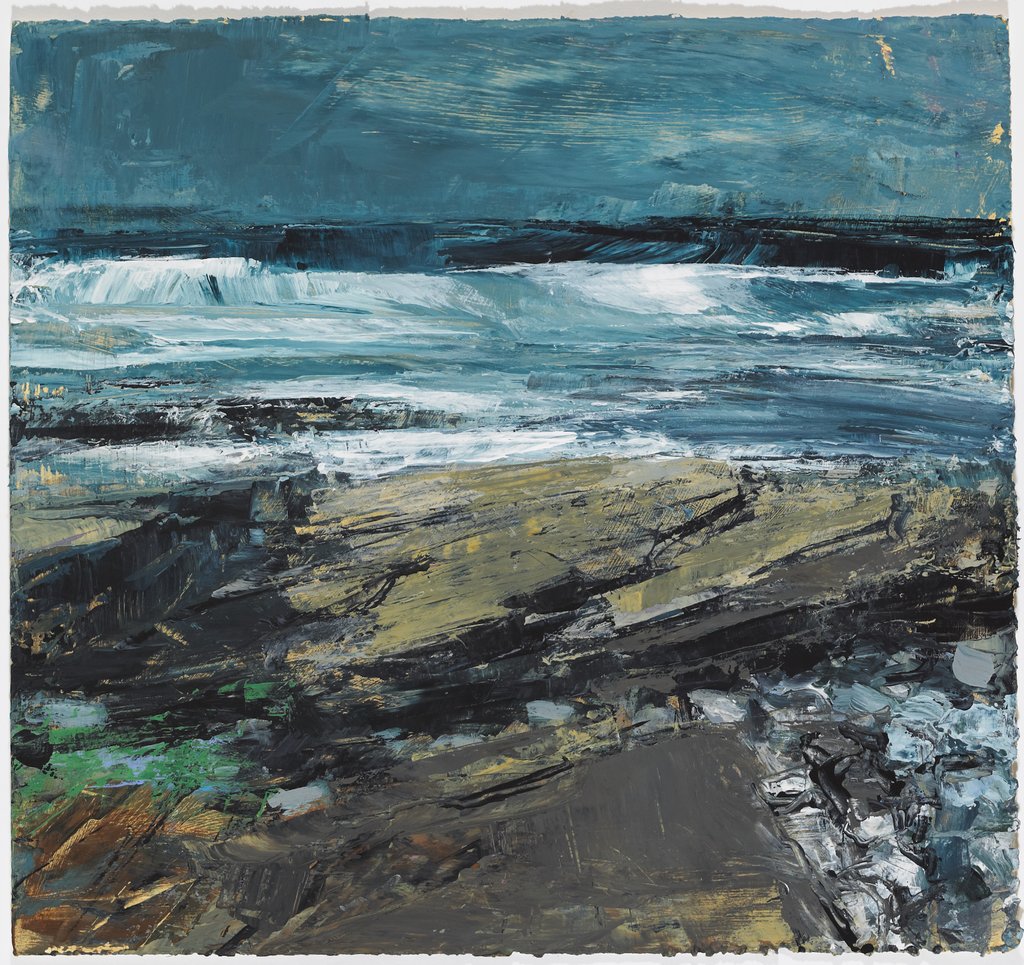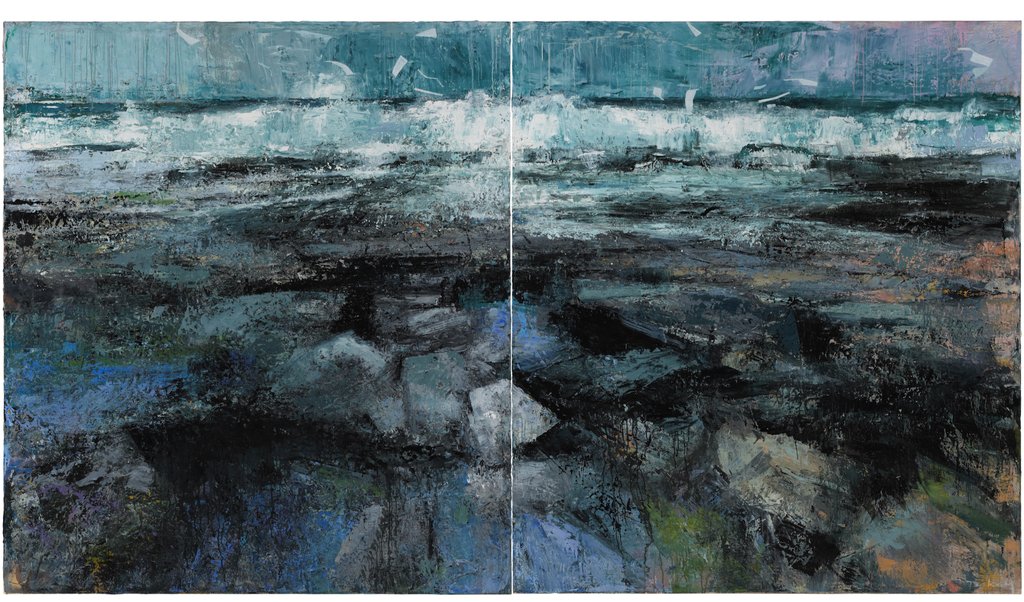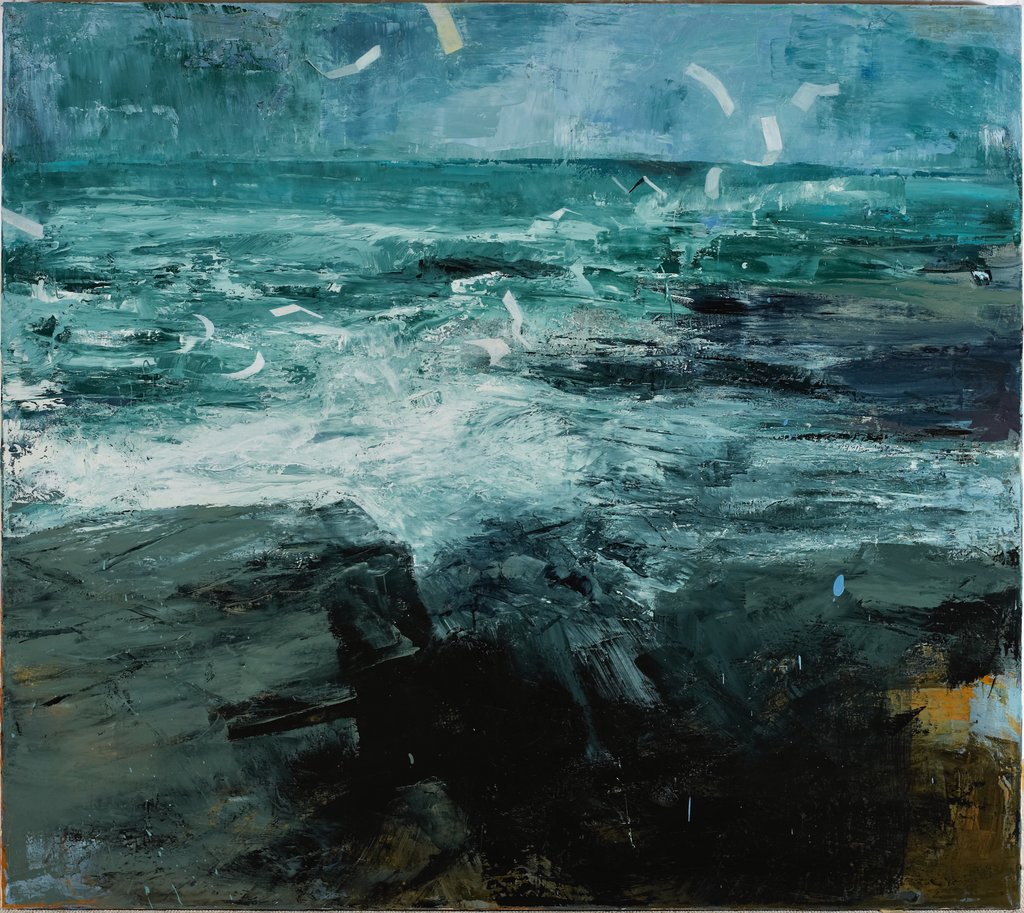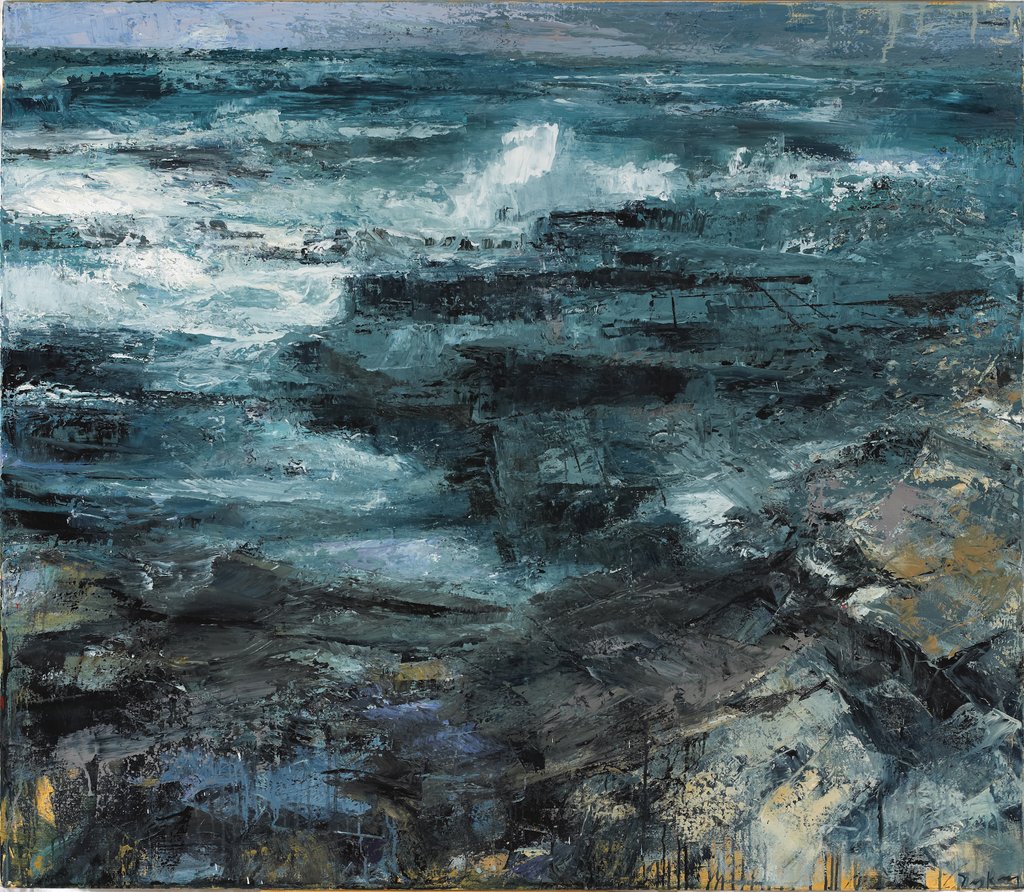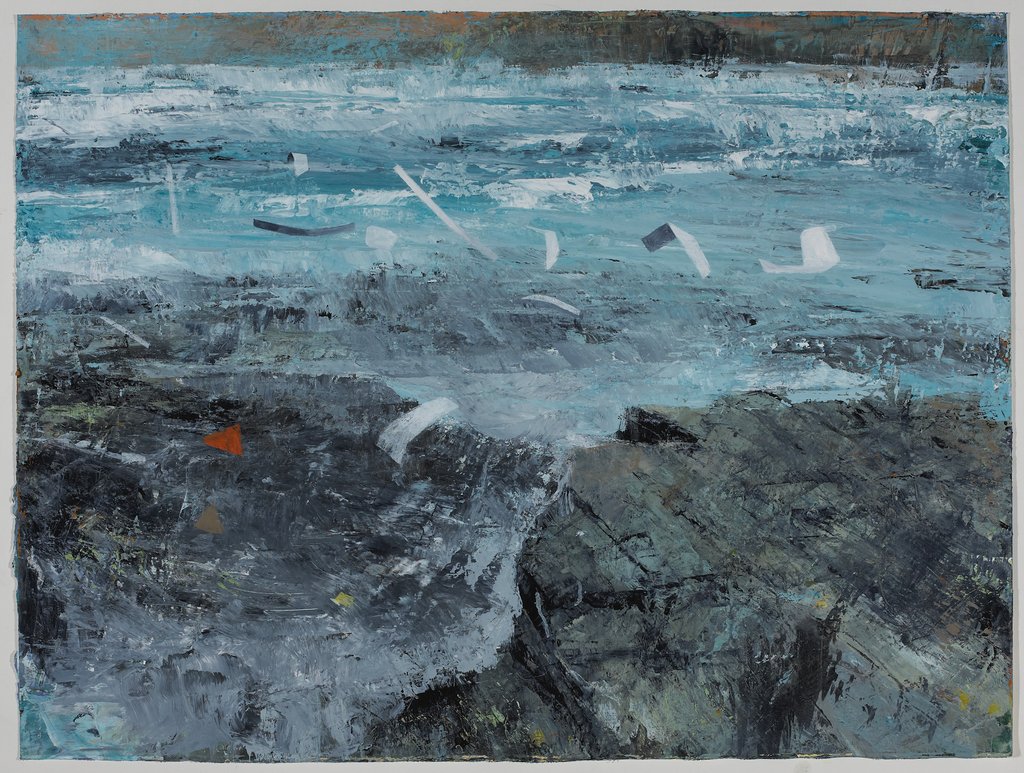Ocean Frequency
Ocean Frequency - Solo exhibition - Oliver Sears Gallery, Dublin
There are two strands in this exhibition: the first, which admirers of his recent work may think familiar, reads as an extension or recapitulation of Teskey’s preoccupation with painting that contested place where sea meets land; the second, a sequence of smaller works, documents a serially interrupted walk inland, a thoughtful progress across semi-cultivated ground...
In the first series, it is true that the artist is revisiting a terrain with which he is familiar, a topography he has painted before, and the resulting works may indeed strike many as familiar. The sea falls on the land with a great weight, and obdurate rock holds out against the incoming sea with a stubborn endurance. There is drama in this primary confrontation, a strong and sometimes exhilarating sense of contention, of irresistible force rolling in a long thunder against immovable object. There is the shock of impact, the strange and unsettling comfort of seeing that impact, that collision of forces, safely frozen before our eyes. There is also an insinuation that you, standing before the painting, are in some sense also standing where the painter stood, seeing, at some slight remove, what he saw, feeling vicariously what he felt, or something of what he felt, standing there on that fault-line in the material world.
In offering the painting as a revisiting of experience, as a painting of a known (or at least knowable) place, the artist offers a version of a lived moment and also a lived-through emotional set — the viewer is invited to project herself or himself to that place where the painter stood, to stand where the white wave falls on the shore and imagine themselves there. If we think of this as a contract in capacity, it is clear that there are two elements to the contract: the capacity of the painter to offer an image sufficiently powerful as to elicit the act of imagination in the viewer, and the capacity of the viewer to respond in force of imagination to that offer. All things being equal, we might say that the work comes into life in this exchange between imaginations, in the flash of lightning across that gap, and that the dramatic mise en scene is a major driver, the source even, of that electrical discharge between two poles of consciousness.
The polarities of light and dark, of sea and land, of mutating time in the moving sea, geological time in the unmoved land, these things serve to set up and underpin the essential nature of the exchange between painter and viewer, between one human existent and another: it is a pure dialectic, all the purer because it takes place inside a deeper and even stranger dialectic, that which takes place between the material world and the immaterial world of consciousness — by which I mean thought, awareness and feeling.
If these sea paintings seem familiar to those who have engaged with Teskey’s work before now, there will be a natural temptation to see them as developments in, or further instances of, a known style delivering in a familiar range of technical ability and aesthetic preoccupation. I think that would be a mistake. I think that a new kind of engagement is proposed in these paintings, an engagement that takes off from what we think we know, and therefore what we think we see. It might even be that those coming to his work for the first time, or from an engagement with other phases of his work but in any case unfamiliar with his previous sea paintings, have an advantage in this engagement.
There are two notable formal developments and one new departure here that, it seems to me, taken together signal a decisive shift in Teskey’s approach to painting.
In the first place, there is a renewed emphasis on drawing, on the gestural power, solidity and vigour of his line. Perhaps this derives from his recent Gearagh series, a response to the sculptural line of those half-submerged remnant trees in their eerie world of half-land, half-water — I don’t know. Whatever has caused it, the drawn matrix that interacts with colours and tones in these sea paintings seems to participate more forcefully than before in some elemental forcefield that holds both sea and land in its web, in its joltings and jaggings and suggestions of purpose felt but not explicit.
In the second place, it is clear that in making these new works Teskey has committed himself more freely than ever before to the act of painting in itself. By this I mean, if you stand in close to the surfaces you can see in the layerings and shifts of focus how tone, knife-scrape and brush-stroke follow and leap from one passage to the next, you can sense the mind and hand following paint and mark, in a kind of dance across the surface, creating sub surfaces, dips, hollows and swatches so that the very skin of paint is delightedly animate with itself. There is still a fidelity to the known place, as edited and chosen for presentation in a particular work by the artist’s mind present to place and to itself, but if that bond is still kept, there is a new bond of excitement with the electric process of painting towards the realization of the work as an end product — as if the painting had somehow become conscious of itself as potential, was in some sense enticing the artist onward in complicity towards its self-realisation.
If the foregoing two elements are to all intents and purposes unfoldings or developments from previous practice, the third element is wholly new. I mean here those airy, buoyant, fluttery but quite exact small shapes that dance over the surfaces of these new paintings. In some of the paintings (Ocean Frequency II and Ocean Frequency IV, for example) these new presences announce themselves clearly; in others, prompted by what we have already seen, we may have to search for them. These presences or shapes are purely gestural in themselves, they are not elements of the topography, nor do they require or invite a literal read as elements introduced into the territory — kites, for instance, or scraps of paper. In a strict sense they do not belong to land, sea or air but to the painting only, considered purely as an object in itself.
A painting, as a material object, is a flat canvas or sheet of paper covered in paint. As such, if we strip out its layers of meaning for the moment, it is a two-dimensional object that we apprehend in a three-dimensional space. There is a measurable distance between that two-dimensional object on the wall and the material being that I am and know myself to be, as I stand there looking at it. Most commonly, that space is experienced as void and unmediated.
The wholly strange effect of these slight presences and shapes dancing across the surfaces is that they appear to me to animate and somehow inhabit the void between me and the paintings, they seem to create an off-surface vortex, barely discernible but emphatically present.
R. G. Collingwood, in his great work on representation, says that for the artist the experience (of the emerging work of art) “develops itself and defines itself in your mind as you paint”.
The persuasive power of this vortex, similarly, develops and defines itself in the time you spend in front of a particular painting. It has two effects worth noting: the first is that it enhances and deepens our imaginative self-projection into the landscape/seascape as presented to us, it sweeps us inward and it necessarily implicates us in the editing and selection process we assume the artist undertook standing before the canvas, which in turn was standing before and also in the actual place; in other words, this powerful ‘illusory’ vortex projects us into the ‘there’ that is being painted. In the second place — precisely because these small modest shapes are no more than shapes, are without content or metaphorical freight — this vortex invites us to engage with the works as pure paintings, that is, as worked surfaces in colour and line that please us as and in themselves, stripped of all except self-grounding content. (The paradox here, of course, is that the vortex itself has neither content nor extension, is literally nowhere).
Perhaps it is best, and simplest, to say this: these shapes, somehow triggering this off-surface vortex, allow us to alternate with enormous rapidity between the painting as topographic reproduction, with all the freight of that, and the painting as a pure object-in-itself. It may even be, given sufficient time, that the habitual viewer of one of these works might succeed in experiencing both complexes of sensation at once, in a kind of sensory-aesthetic fusion.
The pleasures afforded by the series of smaller works are less dramatically obvious, but here again there is the sense that Teskey is pushing into a new kind of engagement, with the work and with the expected viewer. Speedy in their execution, more evidently concerned with recording sensation, these paintings record a trajectory across a landscape stripped to its elements — bare trees, bare swathes of moorland — but also, mysteriously, more hospitable to human kind. It may be a question of scale: where the sea paintings are physically quite large, their very size reinforcing their elemental, almost overwhelming power, these smaller works, even where they refer to or depict large areas of territory, are far less confrontational. Because, deliberately I think, they have something about them of snapshots registering on a moving consciousness, they draw less attention to the making process itself, to the artist as maker; they allow us the fond illusion that the thing or place depicted takes a slight precedence over the individual painting as object in itself, and this allows us to register their existence as a gift from the artist — ‘I saw this and thought you’d like to see it, too, so I painted it for you”. In that kind of relationship with a work, we are more likely to feel a nebulous kind of camaraderie with the artist than to feel challenged by his or her vision, more likely to feel recruited into a shared vision than required to process and assimilate a stern exercise in directed consciousness. Well, that may be a kind of false comfort we offer ourselves on account of the scale of these paintings. It may also be that we respond more easily to these works because where those others deal with brute mindless forces and presences, the monumental fluidity of the sea, the brute geological obduracy of the land, in this suite of smaller paintings we are enfolded in vegetal time, kept safely back from the troubled margins, able to find our way home no matter in what direction we strike out.
Nevertheless, but in perhaps a more unobtrusive way, these paintings, too, carry themselves and us beyond a reductive idea of representation; here, too, we see the self-delighting hand and mind at work, albeit on a more modest scale. Perhaps the plainest indication that these paintings are meant to be enjoyed as paintings is this: the point of resolution in each individual painting is rarely or ever what classical painting proposes as the remous — the point of stillness out of which movement eddies and swirls — that is to say the vanishing point where the discernible lineaments of the composition converge. In these paintings the point of rest can be a balancing of elements in the brushwork, in the juxtaposition of tones, in the balance worked between an element in the landscape and the means employed to evoke that element. In other words, each of these paintings is resolved in terms of the act of working paint, rather than in terms of what is depicted. That, for me, gives these works a sense of living excitement that while congruent with the same sense of excitement in the ‘seascapes’ comes nevertheless from a different place in the art and act of painting.
Theo Dorgan – Dublin 2013
